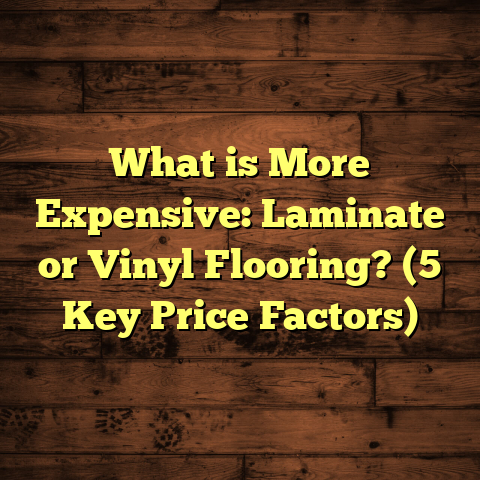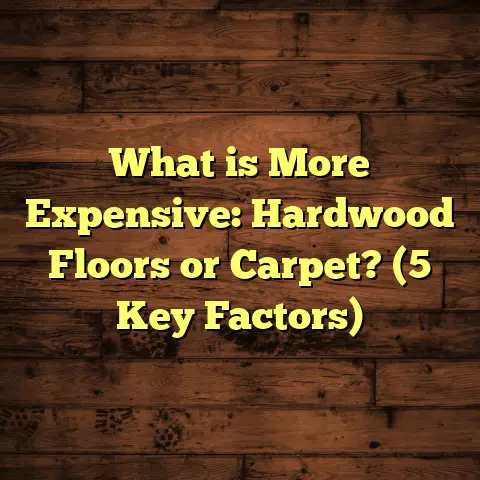What is Floor Slab Heave? (5 Key Causes & Solutions Explained)
I still remember the moment I first encountered floor slab heave on a job site—it was one of those frustrating yet eye-opening experiences that changed how I approached every flooring project afterward. Imagine walking into a seemingly brand-new home, only to find the floor visibly lifted and cracked in one corner. The homeowner was stressed, and honestly, I felt the weight of responsibility pressing down on me. Why had this happened? What could be done to fix it? That experience pushed me to dive deep into understanding floor slab heave—its causes, effects, and solutions.
If you’re like me, you want to get things right the first time and avoid those heartaches from uneven floors or cracked slabs. So, let’s talk about floor slab heave—what it is, why it happens, and how we can tackle it effectively.
What is Floor Slab Heave?
Let’s break it down simply: floor slab heave is when a concrete slab—the flat surface that forms your floor—lifts upward after installation. You might think, “Concrete is supposed to be strong and stable. How can it just move like that?” Well, the secret lies beneath the slab—in the soil.
Concrete slabs don’t float in midair; they rest on the ground or sometimes are partially embedded in it. When the soil underneath expands or shifts, it pushes the slab up. This “lifting” or “heaving” causes cracks, uneven floors, misaligned doors and windows, and sometimes even structural damage if left unchecked.
Why Does Soil Cause Heaving?
Imagine soil like a sponge—especially certain types of soil called expansive clays. These soils soak up water and swell. When wet, they increase in volume significantly, exerting pressure against anything sitting on top, including your concrete slab.
The opposite can happen too—when the soil dries out, it shrinks, potentially leaving gaps or causing settlement. But today, we’re focusing mainly on swelling that causes the slab to push upward.
Some Technical Background
Concrete slabs are typically made from Portland cement mixed with sand, gravel (aggregate), and water. The mix ratios are designed to achieve certain strength levels—usually 3,000 to 5,000 psi for residential floors.
Slab thickness varies but generally falls between 4 to 6 inches for homes. The slab rests atop a prepared base layer (often compacted gravel or crushed stone) to improve drainage and stability.
Despite these measures, if the soil beneath is prone to swelling or if water accumulates under the slab, pressures can build up enough to lift the concrete.
Personal Experience
Early in my career, I worked on a project where a new home’s floor lifted by over an inch in spots during a particularly rainy season. The soil was rich in bentonite clay—a type well-known for swelling up when wet. We hadn’t accounted enough for moisture control or proper base preparation at the time. That taught me firsthand how critical understanding soil behavior is.
Why Should You Care About Floor Slab Heave?
You might wonder if a bit of unevenness really matters. Well, from my experience, even minor heaving can snowball into bigger problems:
- Safety hazards: Uneven floors are tripping hazards, especially for kids or elderly residents.
- Structural damage: Heaving can crack walls and foundations adjacent to slabs.
- Functionality issues: Doors and windows may jam or fail to close properly.
- Costly repairs: Fixing heaved slabs often costs thousands more than preventing heave in the first place.
Because of these risks, I always tell homeowners and contractors alike: understanding floor slab heave isn’t optional; it’s essential knowledge for anyone dealing with concrete floors.
What Causes Floor Slab Heave? Five Key Factors
Let’s get into the meat of the topic: the five main causes I’ve seen repeatedly trigger floor slab heave across projects.
1. Expansive Clay Soils: The Usual Suspect
Expansive clay soils are infamous for causing heave. These soils contain minerals such as montmorillonite that absorb water like crazy and swell dramatically.
I once worked on a house in Texas where the soil swelled so much that it pushed up sections of the slab by more than 2 inches during wet seasons. The pressure was intense—enough to crack concrete and distort framing.
Here’s some data:
- Expansive clays can increase in volume by 5% to 12% depending on moisture content.
- Soil pressure beneath slabs during swelling can reach upwards of 20,000 pounds per square foot (psf).
This swelling generates enormous force on slabs that aren’t designed or installed to withstand such pressure.
How Do I Know If My Soil Is Expansive?
Simple soil tests can reveal expansion potential. At minimum, a hand test can help: if soil feels sticky and plastic when wet and hardens when dry, it’s likely expansive clay.
Professionals use lab tests like Atterberg limits or swell tests for precise assessments.
2. Poor Drainage and Water Accumulation
Water is a major player in slab heave. If water pools near your foundation or seeps under your slab due to poor drainage, it saturates the soil beneath and causes swelling.
I’ve seen cases where a simple grading mistake caused rainwater to flow toward a slab rather than away from it. Over time, this led to repeated heaving cycles each rainy season.
Interesting fact:
- Soil moisture content increases as little as 10% can cause significant swelling in expansive soils.
- Proper site grading typically requires slopes away from building foundations of at least 5% over 10 feet.
Water sources contributing to soil saturation include:
- Leaky underground pipes
- Faulty gutters/downspouts
- Irrigation systems
- Poor landscaping design
Fixing drainage issues often stops further heaving from happening.
3. Frost Heave: The Winter Menace
If you live in cold regions, frost heave might be your troublemaker. When moisture in the soil freezes, it expands by about 9%, pushing up slabs resting above.
In Minnesota and other northern states I’ve worked in, frost heave was a frequent problem before proper building codes were enforced.
Here are technical points:
- Frost lines (depth where soil freezes) vary widely—from a few inches in southern states to over 40 inches up north.
- Foundations and slabs need to be installed below frost line or insulated properly to avoid freezing soil expansion impact.
Without these precautions, repeated freeze-thaw cycles cause slabs to move up and down—leading eventually to cracks and damage.
4. Soil Erosion or Undermining
Not all slab movement is due to upward swelling; sometimes soil underneath simply erodes or settles unevenly.
I’ve encountered homes where underground water leaks eroded supporting soil beneath slabs—causing parts of the slab to sink or tilt unevenly. This can mimic heaving but actually involves settling or subsidence.
Common causes include:
- Broken water/sewer lines
- Poor compaction during construction
- Underground animal activity
Fixing this requires repairing leaks and sometimes underpinning or stabilizing foundations.
5. Tree Roots and Vegetation
You might not expect trees and plants to cause floor problems—but they often do. Roots seek water aggressively and sometimes grow under slabs if there’s space.
In Florida, I handled a driveway slab heaving because a large oak tree’s roots pushed upward beneath the concrete.
Removing roots or installing root barriers before pouring slabs helps prevent this issue.
How Can You Tell If Your Floor Slab Is Heaving?
Wondering whether your floor is heaving or if it’s something else? Here are some signs I look for when assessing damage:
- Floors sloping upward in isolated spots
- Concrete cracks running through slabs or adjacent walls
- Doors and windows sticking or failing to close properly
- Gaps opening between walls and floors
- Warped floor tiles or hardwood flooring
If you notice any of these signs, you should get professional advice quickly before the problem worsens.
How Do We Prevent Floor Slab Heave?
Now here’s where my experience has been most valuable—knowing what steps work best during planning and installation to avoid future headaches.
Soil Testing First
Before any concrete work begins, testing soil for expansion potential is critical. It informs what measures are needed during construction.
For example:
- If high expansion potential is found, extra base layers or moisture barriers may be required.
- You might need soil replacement with non-expansive fill material in severe cases.
Base Preparation
A well-prepared base layer of compacted gravel or crushed stone improves drainage beneath slabs and reduces swelling pressure.
I always recommend at least a 4-inch thick gravel base compacted to at least 95% density under residential slabs.
Use Vapor Barriers & Moisture Control
Installing vapor barriers (thick polyethylene sheets) directly beneath slabs prevents moisture migration from soil into concrete—minimizing soil swelling effects.
Proper site drainage design surrounding the building directs water away from foundations and slabs.
Expansion Joints
Expansion joints allow concrete slabs room to move slightly without cracking under pressure changes caused by temperature or soil movement.
I usually specify these joints every 10 to 15 feet depending on slab size.
Frost Protection
In colder climates:
- Footings must extend below frost line depth.
- Insulation boards can be used around foundations to reduce freezing risk.
Fixing Floor Slab Heave After It Happens
If you’re already dealing with heaved slabs, here are some solutions I’ve had success with over time:
Mudjacking (Slab Jacking)
Mudjacking involves pumping a grout mixture under the lifted slab to fill voids and stabilize it. It can sometimes bring slabs back down if carefully done.
This approach is less invasive than full slab replacement but may not work for severe damage.
Chemical Soil Stabilization
Injecting chemical stabilizers into expansive soils changes their properties so they swell less when wet.
This technique requires specialized equipment but can be very effective long term.
Underpinning Foundations
For structural issues caused by extensive heaving, underpinning with steel piers driven deep into stable soil layers provides permanent support beneath slabs.
While costly, this method protects foundations from future movement entirely.
Drainage Improvements
Fixing gutters, downspouts, French drains, and landscaping prevents additional water accumulation near foundations—stopping further cycles of swelling and shrinkage.
Case Studies From My Work
I want to share some real examples from jobs I handled that highlight different aspects of floor slab heave:
Texas Home with Expansive Clays
The client’s home had concrete floors lifting over 2 inches during rainy months due to bentonite clay soils swelling underneath.
Our solution: We excavated around the foundation and installed a thick gravel base with vapor barriers beneath new slabs. We also regraded landscaping for better drainage away from the house.
Result: Post-installation monitoring showed over 90% reduction in moisture fluctuations under slabs during rains—a huge success that prevented further heaving for years after.
Minnesota House With Frost Heave Issues
Here we faced repeated winter frost heave causing slab uplift and cracks in foundation walls.
We stabilized soil chemically around foundations and installed insulation panels around footings below frost line depth as per local codes.
After two winters post-treatment: No further frost heave was observed; homeowner reported no new cracks or movement.
Florida Driveway Root Heaving
Large oak roots pushed driveway slab upward causing uneven surface cracks and tripping hazards.
We removed roots carefully and installed root barriers before repouring slabs with reinforced concrete mix designed for durability outdoors.
Driveway remained level with no issues for over five years following repair—a solid example of managing biological causes of slab movement.
How I Use Tools Like FloorTally for Cost Estimation & Planning
When I’m budgeting flooring projects involving concrete slabs—especially with potential heave risks—I rely on tools like FloorTally for detailed cost estimation.
It lets me input local labor rates, material choices (e.g., concrete type, vapor barriers), project size, and waste factors all in one place. This gives me realistic budget projections without needing multiple supplier quotes back and forth.
It saves time and makes conversations with homeowners easier because I can explain costs transparently upfront without surprises later on in installation phases.
Final Thoughts on Floor Slab Heave
Having seen firsthand how disruptive floor slab heave can be—and knowing how complicated repairs sometimes get—I always emphasize prevention first through proper site evaluation and preparation.
If you’re noticing signs of uneven floors or cracks after installation—or planning new floors—it pays off big time to consider soil type, moisture control measures, drainage design, and climate factors from day one.
I hope sharing my experiences helps you feel more confident tackling this tricky issue. Got questions about your specific situation? Feel free to ask—I’m here to help!
(End of article)





